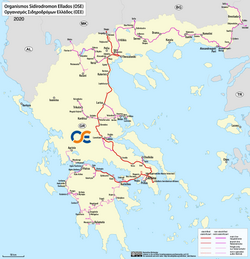Greek railways
| Rail transport in Greece | |||||||
|---|---|---|---|---|---|---|---|

Electric locomotive in Thessaloniki station
|
|||||||
| Operation | |||||||
| National railway | TrainOSE | ||||||
| Infrastructure company | Hellenic Railways Organisation | ||||||
| Statistics | |||||||
| Ridership | 15 million (2014) | ||||||
| Passenger km | 1.413 billion (2014) | ||||||
| Freight | 538 million tonne-km (2014) | ||||||
| System length | |||||||
| Total | 2,238 kilometres (1,391 mi) | ||||||
| Double track | 524 km (326 mi) | ||||||
| Electrified | 494 km (307 mi) | ||||||
| Track gauge | |||||||
| Main | 1,435 mm (4 ft 8 1⁄2 in) | ||||||
| High-speed | 1,435 mm (4 ft 8 1⁄2 in) | ||||||
|
|||||||
| Map | |
|---|---|
 |
|
The railways of Greece have a history which begin in 1869, with the completion of the then Athens & Piraeus Railway, with parts of it also becoming the second-oldest underground metro system in the world. The running of the Greek railways is split between the Hellenic Railways Organisation (OSE), which owns and maintains the infrastructure, and TrainOSE, which runs the trains on the network.
Greece is a member of the International Union of Railways (UIC). The UIC Country Code for Greece is 73.
The Diolkos was a paved trackway near Corinth in Ancient Greece which enabled boats to be moved overland across the Isthmus of Corinth. The shortcut allowed ancient vessels to avoid the dangerous circumnavigation of the Peloponnese peninsula. It is regarded by some as the first railway (as defined as a track to direct vehicles so they may not leave the track) to ever be constructed.
Greek independence in 1832 coincided with the start of the railway era. By 1835 plans were being put to the Greek state to construct a railway line from Athens to the port of Piraeus. Twenty-two years later, in 1857, a contract for its construction was signed and the work commenced. It took four different companies a further twelve years to lay the 8.8 kilometres (5.5 mi) of track, the work being completed in 1869.
Greece towards the end of the 19th century was a collection of small agricultural towns acting as marketplaces and economic centres for the villages that surrounded them. Greece had very little industry and few roads, which made the government think about the development of a railway system that would go towards addressing the lack of internal and external communication that existed. In 1881 the Prime Minister, Alexandros Koumoundouros signed four contracts for the laying of 1,435 mm (4 ft 8 1⁄2 in) standard gauge lines, with the intention of making Greece a pivotal point on the journey between Europe, India and Asia.
...
Wikipedia
